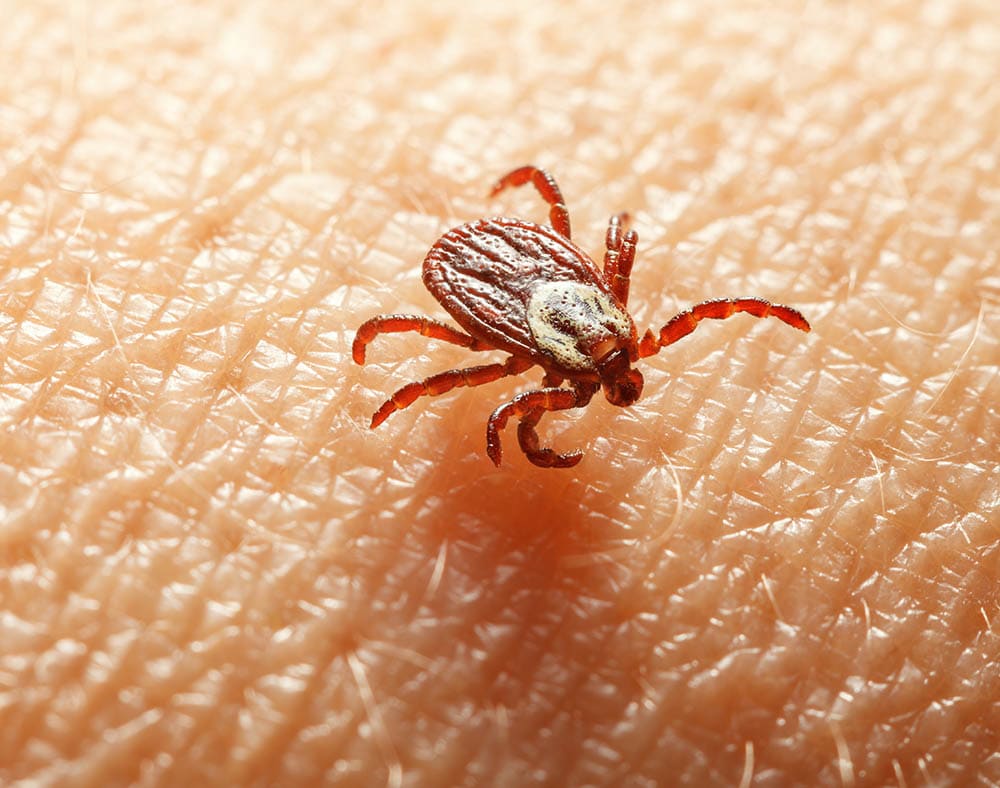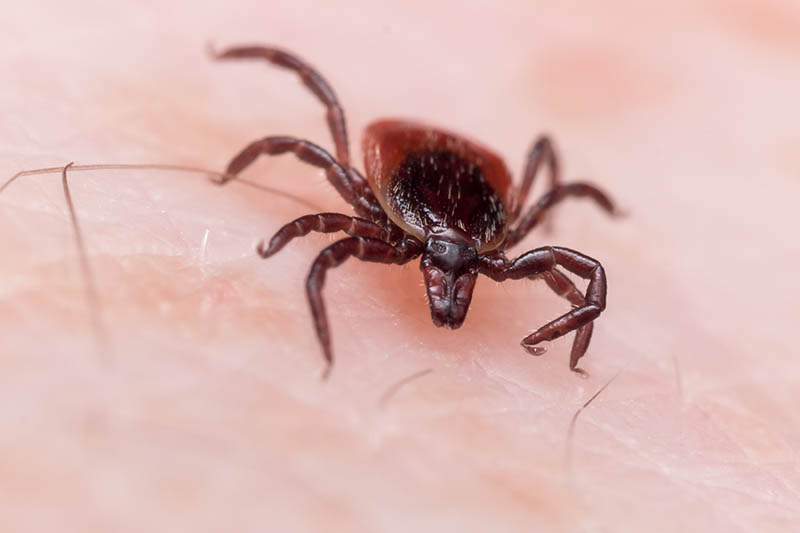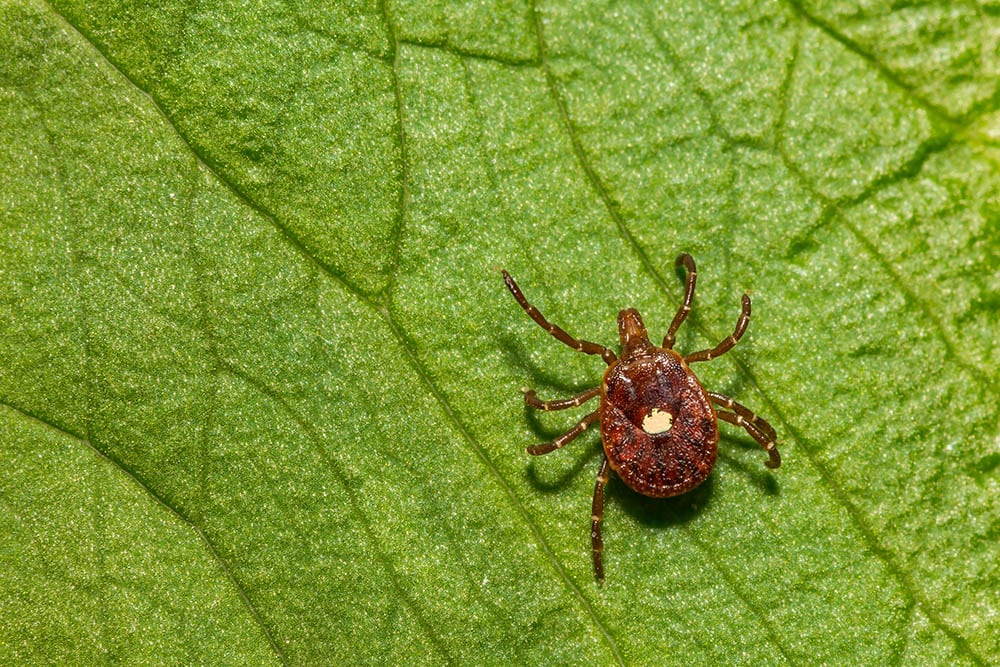5 Different Types of Ticks in Illinois (With Pictures)
-
Jessica Kim
- Last updated:

Ticks are unpleasant parasites that can also be carriers and transmitters of harmful diseases. While there are numerous species of ticks, you can find about five different tick species in Illinois.
While tick populations are more prevalent in wild, less inhabited areas, some species are extremely resilient and can even survive completely indoors. Here’s what you need to know about the common ticks you’ll find in Illinois and how to safely remove and treat tick bites.
The 5 Types of Ticks in Illinois
1. American Dog Tick

| Scientific name: | Dermacentor variabilis |
| Colors: | Reddish brown, gray, white dorsal shield |
| Peak season: | May-June |
American dog ticks can be found all throughout the US, but they’re most prevalent in states east of the Rocky Mountains. They’re resilient and resistant to drying out, so they can be found in drier climates where other tick species aren’t known to survive.
Larvae will usually feed on smaller mammals, like small rodents, and they’ll move on to bigger mammals as they grow into the nymph stage. Adults can use dogs, deer, and humans as hosts, and their peak active season is from May to June.
American dog ticks are carriers of Rocky Mountain spotted fever, tularemia, and canine tick paralysis. They can also carry Lyme disease bacteria, but cannot transmit them to humans and other hosts.
2. Blacklegged Tick (Deer Tick)

| Scientific name: | Ixodes scapularis |
| Colors: | Reddish-orange, brown, black, tan, gray |
| Peak season: | April-May and late-October |
Blacklegged ticks, also known as deer ticks, mostly live in the regions between the Great Lakes and the East Coast. They’re often found in mixed forests and woodland edges and can also live in suburban areas. These ticks have different hosts for each stage of their life cycle. The larvae will have smaller mammals as hosts and move to deer when they reach adulthood.
The peak seasons for blacklegged ticks are April to May and late October. They’re carriers of Lyme disease, anaplasmosis, babesiosis, and the Powassan virus and can transmit them to humans and pets. So, it’s extremely important to remove them from hosts as quickly as possible.
3. Brown Dog Tick

| Scientific name: | Rhipicephalus sanguineus |
| Colors: | Reddish-brown, no marking or patterns |
| Peak season: | Summer |
Brown dog ticks, or kennel ticks, can be found all over the world but prefer warmer climates. They tend to infest places with a lot of dogs, like pet daycares and animal shelters. They’ve completely adapted to indoor life and can survive completely indoors through all life stages as long as they have a sufficient host.
These ticks mostly feed on dogs, and rarely have human hosts. They can transmit Rocky Mountain spotted fever, canine ehrlichiosis, and canine babesiosis.
4. Lone Star Tick

| Scientific name: | Amblyomma americanum |
| Colors: | Reddish-brown, tan, white spot |
| Peak season: | May-August |
Lone Star ticks are mostly found in southern states, but you can still come across them in Illinois, especially in the southern regions. Female Lone Star ticks are easily identifiable as they have a singular spot on their back that’s either white or tan.
These ticks have different hosts for each stage of their life cycle. They mostly latch on to white-tailed deer, but they can also feed on dogs and humans. It’s important to get rid of Lone Star Ticks as quickly as possible because they can transmit diseases harmful to dogs and humans. They can be carriers of Rocky Mountain spotted fever, tularemia, tick paralysis, southern tick-associated rash illness (STARI), and ehrlichiosis.
5. Winter Tick
| Scientific name: | Dermacentor albipictus |
| Colors: | Reddish-brown, dark brown, white markings |
| Peak season: | Fall to winter |
Winter ticks are rarer in Illinois, but it’s still possible to get bitten by one. They’re most prevalent in fall and winter as their larvae hatch in late summer to early fall and stay with a singular host for their entire life cycle.
These ticks prefer latching to moose because moose seem to have a harder time getting rid of them on their own than other ungulates. So, they’re in areas that have higher moose populations. However, they can also be found in deer, elk, and caribou populations.
Winter ticks will occasionally bite dogs, bears, and coyotes, and they rarely bite humans. They also aren’t very dangerous to human health.
How to Safely Remove Ticks in 4 Steps
If you find a tick on your body or your pet, make sure to remove it right away. You can find many devices specifically designed to remove ticks, but a regular fine-tipped tweezer can also help you safely pick them out.

1. Use Fine-Tipped Tweezers to Grip the Tick
Before you use the tweezers, make sure that they’re clean and sterilized. Then, use them to grip the tick as close as possible to the skin’s surface.
2. Pull the Tick Off the Skin Slowly
Once you get a good grip on the tick, slowly pull it up and away from the skin. Don’t twist or wiggle the tweezers because this can cause the mouth parts to break and stay in the skin. If the mouthparts do detach, try using tweezers to pull them out. If they remain stuck, let the skin heal on its own.
3. Clean the Affected Area
Once you pull off the tick, clean the bite area with rubbing alcohol, disinfectant wipes, or soap and water. Monitor the skin for any reactions, rashes, or inflammation, especially if you can’t remove the mouth part. If the skin doesn’t appear normal, call your doctor or veterinarian for further care.
4. Properly Dispose of the Tick
Make sure to properly dispose of a live tick to prevent any other bites or spread of infection. Some of the best ways to get rid of a tick are to wrap it tightly in tape or douse it in alcohol before throwing it in a garbage bin. You can also place it in a sealed bag or flush it down a toilet.
Where to Check for Ticks on Pets
Unfortunately, dogs and cats can become hosts to various species of ticks. Along with giving them tick prevention medication consistently, it’s best practice to do a quick scan of your pet’s body after any time it goes outside. The following are common areas where ticks like to hide:
- In and around ears
- Around eyelids
- Around the tail
- Underneath collars
- Between back legs
- Under front legs
- Between toes
Conclusion
Even the most cautious people can get tick bites. So, it’s important to be able to identify different types of ticks and know what types of areas they commonly inhabit. Always do a quick body scan after spending prolonged amounts of time outdoors. If you find a tick bite, remove the tick as quickly as possible and dispose of it properly.
If the type of tick is known for transmitting diseases, get in touch with a healthcare professional or veterinarian for follow-up care. It’s best to be safe than sorry, and being prepared and aware can reduce the risk of more harm coming your way after getting bitten by a tick.
- Related Read: 9 Types of Ticks in Louisiana
Featured Image Credit: Catkin, Pixabay
Contents

